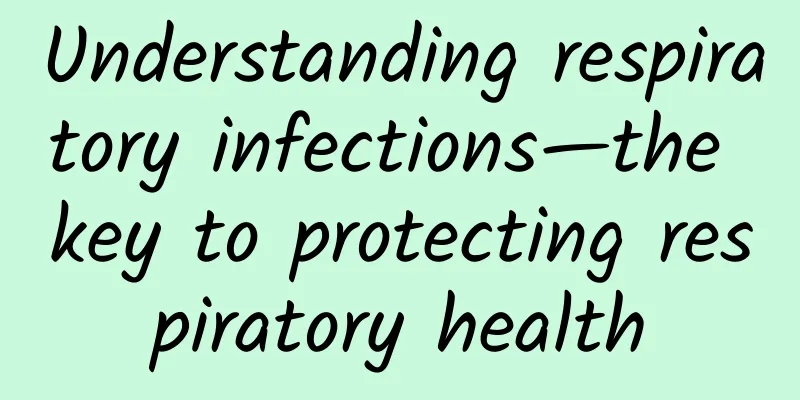Understanding respiratory infections—the key to protecting respiratory health

|
Our respiratory system is an important line of defense for the body. It inhales oxygen and expel carbon dioxide for us every day. However, when this line of defense is damaged, our health will be seriously threatened. Respiratory infectious diseases are a type of disease that mainly attacks the respiratory system. They spread rapidly through air, droplets, direct contact and other channels, posing a huge health threat to human society. In order to better protect our respiratory health, it is crucial to understand respiratory infectious diseases and their prevention and treatment measures. 1. Overview of respiratory infectious diseases Respiratory infectious diseases are a type of infectious disease caused by viruses, bacteria and other microorganisms, which are mainly transmitted through air, droplets, direct contact and other channels. Common respiratory infectious diseases include influenza, measles, rubella, chickenpox, meningitis, whooping cough, etc. These diseases not only have a serious impact on the health of patients, but may also cause serious complications and sequelae. The main route of transmission of respiratory infectious diseases is airborne transmission, that is, when patients cough, sneeze or talk, droplets containing pathogens are produced. When healthy people inhale these droplets, they may be infected. In addition, direct contact and interpersonal transmission are also important routes of transmission of respiratory infectious diseases. II. Preventive measures for respiratory infectious diseases 1. Maintain social distance Respiratory infectious diseases are mainly transmitted through droplets, so maintaining social distance is one of the important measures to prevent respiratory infectious diseases. It is recommended to keep a distance of at least 1 meter in public places and when in contact with others, and avoid close contact and hugging. 2. Pay attention to personal hygiene, wash hands frequently and wear a mask Frequent hand washing is one of the basic measures to prevent respiratory infectious diseases. After contact with the external environment, wash your hands thoroughly with soap and water, especially after coughing, sneezing or contact with patients with respiratory infections. In addition, in public places and crowded places, it is recommended to wear a mask to reduce the risk of droplet transmission. 3. Avoid contact with patients with respiratory infections Contact with patients with respiratory infections increases the risk of contracting respiratory infectious diseases. Therefore, contact with such patients should be avoided as much as possible, especially for high-risk groups such as children, the elderly, and pregnant women. 4. Avoid going to crowded places Crowded places are prone to the spread of respiratory infectious diseases. If you must go to crowded places, you should take protective measures, such as wearing a mask and washing your hands frequently. 5. Pay attention to air circulation Poor indoor ventilation can easily increase the risk of respiratory infections. Therefore, attention should be paid to indoor ventilation and air circulation, especially when there are people indoors. It is recommended to use air purifiers or open windows to improve indoor air quality. 6. Avoid contact with animals and polluted environment Contact with animals and contaminated environments may increase the risk of contracting respiratory infectious diseases. Therefore, contact with animals and contaminated environments should be avoided as much as possible, especially during epidemics. 3. Treatment of respiratory infectious diseases 1. Medication Symptomatic treatment: For different respiratory infectious diseases, take corresponding symptomatic treatment measures, such as reducing fever, suppressing cough, and reducing inflammation. Antibiotic treatment: For bacterial respiratory infections, such as pneumonia, antibiotics are needed for treatment. However, antibiotics should be used under the advice of a doctor to avoid abuse. Antiviral drugs: Antiviral drugs can be used to treat viral respiratory infectious diseases, such as influenza, but they need to be used under the guidance of a doctor and pay attention to the side effects and drug resistance of the drugs. 2. Traditional Chinese Medicine Treatment Traditional Chinese medicine treatment: Treatment is carried out with traditional Chinese medicine prescriptions or Chinese patent medicines, such as traditional Chinese medicine prescriptions for clearing heat and detoxifying, promoting lung function and relieving cough, as well as Chinese patent medicines such as Isatis root granules and Shuanghuanglian oral liquid. Acupuncture treatment: Acupuncture is used to stimulate specific acupoints to regulate the body's qi and blood circulation and immune function, and relieve the symptoms of respiratory infectious diseases. 3. Physical therapy Nebulizer inhalation: Using drugs for nebulizer inhalation treatment can relieve symptoms such as cough and asthma. Acupoint massage: Use acupoint massage methods to stimulate specific acupoints, regulate the function of the human respiratory system, and relieve the symptoms of respiratory infectious diseases. 4. Immunotherapy Immunoenhancers: Use immunoenhancers such as thymosin, interferon, etc. to enhance the body's immunity and prevent and treat respiratory infectious diseases. Vaccination: For high-risk groups such as children, the elderly, pregnant women, etc., corresponding vaccines such as influenza vaccine, pneumonia vaccine, etc. should be administered to prevent the occurrence of respiratory infectious diseases. 5. Nutritional support Vitamin supplements: Appropriate supplementation of vitamins such as vitamin C and vitamin E can improve the body's immunity and prevent and treat respiratory infectious diseases. Reasonable diet: Maintaining a nutritionally balanced diet and eating more vegetables, fruits, whole grains and other foods rich in antioxidants can help prevent and treat respiratory infectious diseases. IV. Public awareness enhancement and health education Public awareness and knowledge are very important for preventing and treating respiratory infections. Here are some suggestions: 1. Enhance the public's awareness of prevention: Promote knowledge on the prevention of respiratory infectious diseases through various channels, such as television, radio, newspapers, community publicity, etc., so that the public can understand the hazards and prevention methods of respiratory infectious diseases. 2. Enhance the public's confidence in treatment: Through publicity and education, the public can understand the curability of respiratory infectious diseases, enhance patients' confidence, and avoid delaying treatment due to fear. 3. Promote a healthy lifestyle for the public: Through health education, guide the public to develop good living habits and a healthy lifestyle, such as a proper diet, moderate exercise, and adequate sleep. 4. Enhance the public's awareness of reporting: educate the public to seek medical treatment in a timely manner when they find symptoms of suspected respiratory infectious diseases, and actively inform their doctors of their travel history, contact history and other information to facilitate early diagnosis and treatment. 5. Strengthen the health management of public places: educate managers of public places to strengthen air circulation in the places, take measures such as regular disinfection, and reduce the spread of respiratory infectious diseases from the source. 6. Emphasize the importance of vaccination: educate the public to realize that vaccines are one of the effective means to prevent infectious diseases, especially for high-risk groups, who should actively receive the corresponding vaccines. 7. Establish a health record and health education system: Encourage individuals to establish health records to record their health status and vaccination status; at the same time, advocate the participation of all people in health education activities to improve the health literacy and self-care ability of all people. Conclusion The key to protecting respiratory health lies in the in-depth understanding and active prevention of respiratory infectious diseases. Through the discussion in this article, we have learned about the transmission routes, prevention measures and treatment strategies of respiratory infectious diseases. We emphasize the importance of key measures such as maintaining personal hygiene habits, enhancing immunity, and vaccination. At the same time, we also emphasize the importance of public awareness and health education on respiratory infectious diseases. In order to better protect our respiratory health, we need to start with ourselves and take active preventive measures. At the same time, we must also be vigilant and promptly detect and treat respiratory infectious diseases. Author of this article: Li Feizhou, Xing'an Jieshou Orthopedic Hospital, Guilin, Guangxi |
<<: Knowledge on preventing puerperal infection
>>: What are the nursing measures for sleep apnea syndrome?
Recommend
Common but uncommon bacillary dysentery
Author: Chen Dianjie, Fifth Medical Center, PLA G...
Do women need to replenish blood in 12 key parts?
Because women lose a lot of blood during their mo...
What causes breast fibroids?
The breasts of women are the most important part ...
Postpartum rheumatic symptoms
Postpartum rheumatism is a relatively common dise...
The benefits of having sex during breastfeeding
A woman's lactation period refers to the peri...
Don’t be angry or anxious! These skin problems that damage your appearance are all psychologically related.
A suggestion for everyone Be happy now! Image sou...
Pregnant woman has difficulty breathing
Although pregnant women are prone to dizziness du...
What to do with flat chest? Is there any way to enlarge breasts?
Having an angelic face and a charming figure has ...
The best time to determine the fetal position of the second pregnancy
Most expectant mothers hope that they can give bi...
The harm of women crossing their legs
What are the dangers of women crossing their legs...
What to do if a pregnant woman has a fever
We all know that what women worry about most afte...
What is the software for delivering medicine to your door? Which app is it for buying medicine online and delivering it to your door?
Which app can I use to buy medicine online and ha...
“Wolf Warrior” Handbook | Known as the “immortal cancer”, is it really that scary?
Systemic lupus erythematosus (SLE) is called the ...
How long does it take for chest pain to go away during early pregnancy?
In the early stages of pregnancy, there will be s...
Can women eat mullet during menstruation?
Menstruation is a special period. Many people wil...









